Infineon and MCI supply sensors for air quality measurement to schools in Carinthia and Tyrol
Villach, Innsbruck - Five HTLs in Carinthia and six HTLs in Tyrol have received high-precision CO2 sensors from Infineon Austria and MCI in Innsbruck. The teams of students use them to build CO2 alarm lights to indicate ventilation and reduce the risk of infection. A total of 300 classrooms will be equipped.
Indoor CO2 levels are an important indicator of air quality. Particularly in the current pandemic, this value can help contain the spread of viruses. Regular cross-ventilation and shock-ventilation of classes – in addition to ongoing testing and mask-wearing - is therefore also included in the specifications of the Ministry of Education. But when is it time to ventilate? Infineon and the MCI are providing the CO2 sensor kits free of charge to 11 technical teaching institutions in Carinthia and Tyrol in order to use state-of-the-art technology to draw attention to the need for timely ventilation in the classroom.
Creating a benefit with education and know-how
In the spirit of 'learning by doing', the young technical talents use Infineon sensors to build their own air quality measurement systems that warn of excessive CO2 concentrations and thus reduce the risk of virus transmission.
Learning in a healthy indoor environment is of paramount importance, especially in times like these. Sabine Herlitschka, CEO Infineon Austria: "With our initiative we want to support the young talents in their technology education and enable a healthy learning atmosphere in the classroom. The students as well as the teachers are actively involved, can combine the knowledge of several subjects - from electronics, computer science to physics - and combine it with health-related topics. This encourages participation, strengthens team spirit and creates digital solutions with a benefit for the entire school."
Precise sensor measures air quality and saves energy
At the heart of the CO2 sensor is an Infineon module based on XENSIV PAS technology. It measures the CO2 content precisely, reliably and continuously. In addition, other parameters such as temperature, humidity or air pressure are measured. As soon as a limit value is exceeded, an alarm can be triggered via alarm light. According to the Ministry of the Environment, the CO2 (carbon dioxide) concentration in classrooms should not exceed an average of 1,000 ppm (parts per million, i.e. 0.1 percent by volume). Since the concentration of aerosols through which the virus is transmitted correlates with the concentration of CO2, the sensor can help ensure that people can meet in safe indoor-conditions - whether in the office, at school or at home.
"We have created an easy-to-use system solution in our innovation lab, the "Emerging Applications Lab", which is run jointly with Infineon, and it is already in use in 12 lecture halls in Innsbruck. Another 50 lecture hall systems are in preparation. With the display of the CO2 value, we have an objective benchmark for the energy-efficient supply of fresh air, can ventilate according to demand and avoid unnecessary energy losses, especially during the winter season. We are happy to pass on this research know-how to the schools," says MCI Rector Andreas Altmann.
STEM talents and schools network
In Carinthia, the HTL in Villach, Klagenfurt Mössinger- und Lastenstraße, Wolfsberg and Ferlach are participating. In Tyrol, the HTL Innsbruck Trenkwalderstraße, in Jenbach, Kramsach, Lienz, Imst and IKA Reutte. At school, the students learn to build and program a CO2 alarm light under the guidance of the teachers. This allows them to deepen their hardware and software knowledge, create a digital design with LED lights and acoustic signals, control the system and expand it to an Internet-of-Things platform. To this end, a dedicated developer forum was set up across the schools to network, share knowledge and develop ideas for further innovations. Digital technologies thus offer real added value for education and collaboration.
Smart building management at HTL Villach
The school team at HTL Villach is going one step further: the CO2 sensors are not only being used in the classes, but are also to be integrated into the technology of the building conversion currently underway. Networking with the infrastructure control concept will enable automated and continuous data collection and data evaluation for the entire school. For example, noise levels could also be measured in the future.
This practical collaboration between industry and education shows how STEM subjects (Science, Technology, Engineering, and Mathematics) can be used to create smart solutions for topics at the cutting edge of technology. Thus, it is an active contribution to practice-oriented education, as well as to qualified technical specialists in the region.
About MCI | The Entrepreneurial University®
The Entrepreneurial University combines elements and features of universities, business schools, grande écoles, universities of applied sciences, business and consulting. With its unique concept, it stands for science, studies and advanced education, for internationality, quality, innovation, practice orientation, cooperation with business and industry, solution-oriented research and development, top infrastructure, customer and service orientation and international renown. Since 2016, Infineon has been operating the "Emerging Applications Lab" in cooperation with MCI. In this innovation lab, Infineon sensors are used to develop so-called system demonstrators, which are used, for example, for motor controls in collaborative robotics or high-frequency power electronics with gallium nitride semiconductors. For more information please refer to www.mci.edu
About Infineon Austria
Infineon Technologies Austria AG is a group subsidiary of Infineon Technologies AG, a world-leading provider of semiconductor solutions that make life easier, safer and greener. Microelectronics from Infineon reduce the energy consumption of consumer electronics, domestic appliances and industrial facilities. They make a major contribution to the convenience, security and sustainability of vehicles, and enable secure transactions in the Internet of Things.
Infineon Austria pools competencies for research and development, production as well as global business responsibility. The head office is in Villach, with further branches in Graz, Klagenfurt, Linz and Vienna. With 4,820 employees from 73 countries (including 2,100 in research and development), in the financial year 2021 (ending in September) the company achieved a turnover of € 3.9 billion. With a research expenditure of 516 million euros, Infineon Austria is one of the strongest research companies in Austria.
Press Photos
-
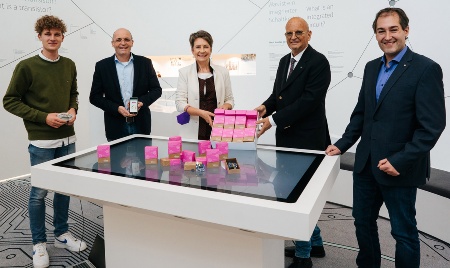 Official handover of the CO2 sensors mid of November from left : Niklas Vavpic - student representative HTL Villach, Hanspeter Fischer - Project Manager Infineon, Sabine Herlitschka - CEO Infineon Austria, Peter Kusstatscher - Director HTL Villach, Martin Santner - Division Board HTL Villach © InfineonCO2-Sensor-Handout-Kaernten-HTL-Villach
Official handover of the CO2 sensors mid of November from left : Niklas Vavpic - student representative HTL Villach, Hanspeter Fischer - Project Manager Infineon, Sabine Herlitschka - CEO Infineon Austria, Peter Kusstatscher - Director HTL Villach, Martin Santner - Division Board HTL Villach © InfineonCO2-Sensor-Handout-Kaernten-HTL-VillachJPG | 831 kb | 2953 x 1761 px
-
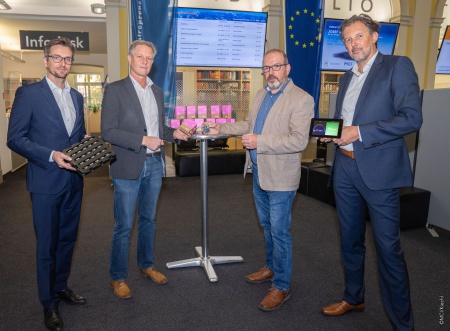 Handover mid of November in Tyrol from left: Michael Kraxner - MCI, Head of Research & Development, Ronald Stärz - MCI, Head of Emerging Applications Lab, Georg Strauss - Di-rector of HTL Jenbach, Andreas Mehrle - MCI, Head of Department & Course of Studies Mechatronics ©MCI/KiechlCO2-Sensor-Handout-Tirol-HTL-Jenbach
Handover mid of November in Tyrol from left: Michael Kraxner - MCI, Head of Research & Development, Ronald Stärz - MCI, Head of Emerging Applications Lab, Georg Strauss - Di-rector of HTL Jenbach, Andreas Mehrle - MCI, Head of Department & Course of Studies Mechatronics ©MCI/KiechlCO2-Sensor-Handout-Tirol-HTL-JenbachJPG | 861 kb | 2126 x 1565 px
-
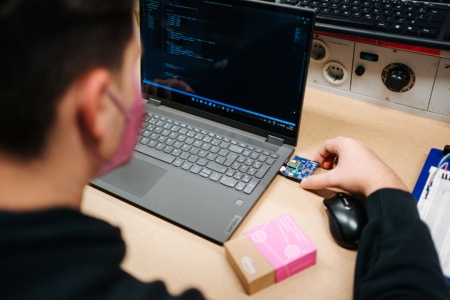 The CO2 sensor measures the carbon dioxide concentration and draws attention to timely ventilation. ©InfineonInfineon-Sensor-Schule
The CO2 sensor measures the carbon dioxide concentration and draws attention to timely ventilation. ©InfineonInfineon-Sensor-SchuleJPG | 350 kb | 1772 x 1181 px
-
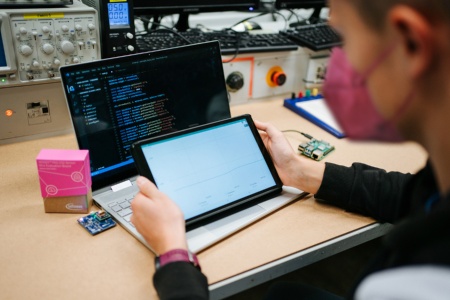 The CO2 sensor measures the carbon dioxide content in the air precisely, reliably and continuously ©InfineonInfineon-Sensor-Schule2
The CO2 sensor measures the carbon dioxide content in the air precisely, reliably and continuously ©InfineonInfineon-Sensor-Schule2JPG | 551 kb | 1772 x 1181 px
-
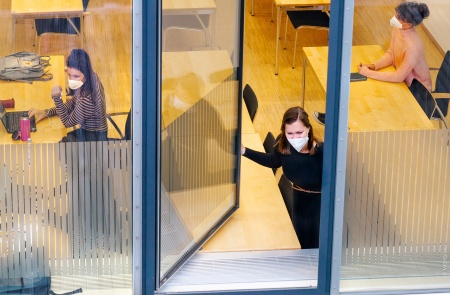 Regular cross-ventilation and shock-ventilation of classes - in addition to ongoing testing and mask-wearing - are required by the Ministry of Education. ©MCI/Geissler211201-Infineon-Sensoren-MCI-I-5
Regular cross-ventilation and shock-ventilation of classes - in addition to ongoing testing and mask-wearing - are required by the Ministry of Education. ©MCI/Geissler211201-Infineon-Sensoren-MCI-I-5JPG | 942 kb | 2362 x 1549 px
-
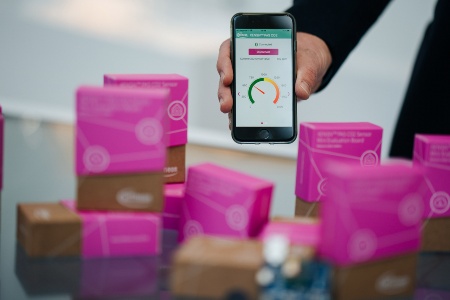 The CO2 sensor measures the carbon dioxide concentration and draws attention to timely ventilation. ©InfineonCO2-Sensor-Ampel-
The CO2 sensor measures the carbon dioxide concentration and draws attention to timely ventilation. ©InfineonCO2-Sensor-Ampel-JPG | 630 kb | 2953 x 1969 px
